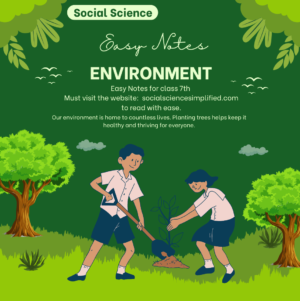Introduction :
In this chapter, we will learn about the environment, which includes everything around us like air, water, land, plants, animals, and even buildings and roads. We’ll explore its different parts and understand why it’s important to take care of our planet.
Meaning of Environment :
The environment is everything that surrounds us, like air, water, land, plants, animals, and even buildings and roads. It’s important because it supports all life on Earth.
Components of Environment:
There are three components of Environment and these are:-
- Natural: Things that occur naturally without human intervention.
- For Example:- Land, air, water, mountains, rivers, forests, oceans, animals and all human beings.
- Human made: Things created or made by human beings.
- For Example:- Buildings, dams, roads, Vehicles, Industries, Monuments etc.
- Human: People are also the components of Environment.
- For Example:- Individual, Family, Community, Religion, Education, Political Situation etc.
What makes up our Environment?
The environment is made up of two main types of factors:-
- Biotic Factors: These are the living things, like plants, animals, and tiny organisms.
- Abiotic Factors: These are the non-living things, like air, water, soil, sunlight, and rocks.
Together, these factors interact and create the world around us.
Natural Environment :
The natural environment includes land, water, air, plants, and animals.
- Lithosphere: The solid crust or hard top layer of the earth. Made of rocks and minerals, covered by soil. Features various landforms like mountains, plateaus, plains, and valleys. Provides resources like forests, grasslands, and minerals.
- Hydrosphere: The domain of water, including rivers, lakes, seas, and oceans. Essential for all living organisms.
- Atmosphere: The thin layer of air surrounding the earth, held by gravitational force. Protects from harmful sun rays and consists of gases, dust, and water vapor. Influences weather and climate.
- Biosphere: The zone where land, water, and air interact to support life. Includes all living organisms.
Ecosystem :
An ecosystem is the relationship between living organisms and their surroundings. Examples include rainforests, grasslands, deserts, mountains, lakes, rivers, oceans, and ponds.
Human Environment :
Human Environment includes all the changes humans have made to fit their needs.
- Early humans lived simply and used nature’s resources.
- Over time, people learned to grow crops, keep animals, and build homes.
- Key Developments:
- Wheel: Made moving things easier.
- Farming: Produced more food.
- Barter System: Enabled trading goods.
- Trade and Commerce: Expanded with more food and goods.
- Industrial Revolution: Allowed large-scale production and faster transportation.
- Information Revolution: Made global communication quick and easy.
Keeping the Balance: Nature and Human Life :
- Enjoying foods like watermelon in summer and peanuts in winter shows the need to balance between nature and human activities.
- It’s important to use and care for our environment in a way that keeps it healthy for the future.


